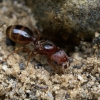Next year I plan on trying to obtain all species of Camponotus native to my state, by myself without buying, taking established colonies, or trading with other antkeepers in my state. So far I have documented all species except for C. subbarbatis, which has been found in extreme south western MA. I think this is definetly going to be a challenge, last year with covid I had tons of spare time to go anting and exploring, although with school in session, missing nuptial flights is going to be inevitable.
•With the exception of C. Subbarbatis, colony collection is not allowed
•I’m not sure if I’m going to take it to another level, but I found C. Discolor near my backyard, so technically I’ll need to find a queen to actually have all the species. But, the population could have died out among other things, so I don’t think I’ll be looking for them, unless somehow someway I find a queen within the next couple of years.
First off, the Camponotus caryae
My slowest growing and smallest colony of the bunch, I think caryae has to be the cutest colony I have. They are tiny little bubbles of energy, especially after a sugar water feeding. In the summer months they are extremely easy to keep, when I feed them they balloon up (especially the queen) to insane sizes, unlike any other Camponotus I’ve kept. This makes it so I only have to feed them sugars once a month, along with proteins every week or so.
She got nanitics on July 5 and is currently at 7 workers with a small pile of larvae. They had a small dehydration episode where they lost a worker and about half there brood pile
 , due to their test tube drying out. I absolutely love caryae, they are extremely low maintenance, brilliantly colored, and large enough to actually see and appreciate their physical features.
, due to their test tube drying out. I absolutely love caryae, they are extremely low maintenance, brilliantly colored, and large enough to actually see and appreciate their physical features.July 7th

July 15th

Now


Sorry, most of these pictures aren’t the greatest, all were taken with improper lighting.
Camponotus novaeboracensis
I’ve had a lot of ups and downs with them, and thankfully they have recovered very well from the downs since their Queen is insanely productive. Through dehydration, overheating and floods, they have always prevailed. So cheers to a bright future for them, given I don’t do something to kill half the colony again
 .
. Capture pic

June 18

Now


Again sorry for the potato quality
Camponotus chromaiodes
IMO the best colored Camponotus I’ve kept besides caryae, I don’t know why it is about them but I absolutely adore the rusty maroon thorax, with a fading shade into the abdomen. The workers have that same golden dusting of hairs as Camponotus Pennsylvanicus as well, which only compliments them more. I just love them if you can’t already tell
 . They have 20 workers on the dot and overall have been doing very well, with no setbacks or any dull moments, although they don’t have a major yet, which is mildly infuriating. They eat like champs, and hopefully they have a great growing season next year
. They have 20 workers on the dot and overall have been doing very well, with no setbacks or any dull moments, although they don’t have a major yet, which is mildly infuriating. They eat like champs, and hopefully they have a great growing season next yearCapture pic

June 18th

July 14

Now

Sorry, I know a lot of these pics are very unprofessional.
So that’s all for now, next year I plan on moving them all into mini hearths. Not sure why I started a journal at this time in the year, since they will all be hibernating until Marchish. Anyways, take care and I hope your ants are doing well!
(My apologies for any spelling/grammar mistakes)
Edited by Antkeeper014, December 14 2020 - 7:59 AM.
















